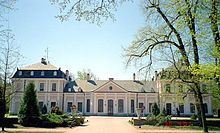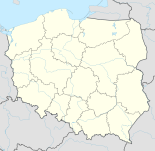Sieniawa
| Sieniawa | ||
|---|---|---|

|
|
|
| Basic data | ||
| State : | Poland | |
| Voivodeship : | Subcarpathian | |
| Powiat : | Przeworski | |
| Gmina : | Sieniawa | |
| Area : | 6.76 km² | |
| Geographic location : | 50 ° 10 ′ N , 22 ° 36 ′ E | |
| Residents : | 2164 (December 31, 2016) | |
| Postal code : | 37-530 | |
| Telephone code : | (+48) 16 | |
| License plate : | RPZ | |
| Economy and Transport | ||
| Street : | Przeworsk - Lubaczów | |
| Next international airport : | Rzeszów Airport | |
Sieniawa is a Polish city in the Subcarpathian Voivodeship , Powiat Przeworski in the basin of Sandomierz am San with about 2160 inhabitants. It is the seat of the town-and-country municipality of the same name . The history of the place is closely connected with the noble family of Czartoryski .
history
On the floor of the village Dybków founded in the year 1676 the voivode of Volhynia and Feldhetman the Crown Mikołaj Hieronim Sieniawski , one of the richest men in the Polish-Lithuanian Rzeczpospolita , a city. At the same time, the construction of the castle, the park and harbor as well as storage houses for the trade began. The city was secured against threats from the east, especially the Tatars , with fortifications . Ultimately, however, the flourishing grain trade on the San and Vistula was primarily responsible for the establishment. The population of the new city consisted primarily of Roman Catholic Poles, Jews and Greek Catholic Ruthenians.
In 1731, through the marriage of Maria Zofia Sieniawska to August Aleksander Czartoryski , the town passed into the possession of the no less important Czartoryski family , who belonged to Sieniawa until 1939/1944. During the first partition of Poland in 1772, Sieniawa fell to Austria and developed into a craft and trade center. In the 19th century the city became a center of East Central European Judaism, especially popular Hasidism . In 1896 the town charter was temporarily lost (until 1934). In 1918 Sieniawa became Polish again. Before the start of World War II , Jews made up almost 60% of the population. During the two-year occupation by the Soviet Union from September 1939, the place was called Sinjawa (Синява) and from the beginning of 1940 it was the center of the Sinyava Rajon as part of the Lvov Oblast , after which the German Wehrmacht moved into the city in June 1941. The Germans set up a ghetto in which around 3,000 Jews were murdered by 1942. The remainder were deported to the Belzec extermination camp . As a result of the war - Sieniawa was also a center of the Polish and Soviet partisan movements - the city was largely destroyed. After the city was retaken by the Red Army in the summer of 1944 ( Lviv-Sandomierz operation ), the town officially remained a part of the Soviet Union until October 1944, but was then returned to Poland together with the Rajon, and the town has been part of Poland since then .
Attractions

- The town is arranged according to the pattern from the time it was founded in the 17th century
- Palace and park ensemble of the Czartoryski family
- Catholic parish church of Our Lady, built in 1719 based on a design by Giovanni Spazzio . Rebuilt after being destroyed in the 1920s. Contains the tomb of those of Czartoryski
- Former parish church of St. John the Baptist from 1757, 1788 to 1947 Church of the Uniate
- Town hall from the second half of the 17th century, destroyed in the Second World War and then rebuilt
- Old fortifications
local community
In addition to the city, the urban-and-rural community of Sieniawa includes other places with around 7,000 inhabitants.
Personalities
- Adam Kazimierz Czartoryski (* 1734 in Danzig, † 1823 in Sieniawa), Polish and Austrian general
- Stanisław Madeyski (* 1841 in Sieniawa), Austrian Minister of Culture.
Web links
- City website (Polish)
- Castle in Sieniawa Palace

